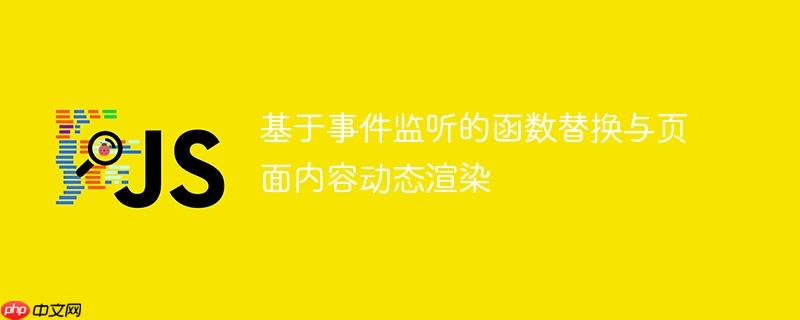
正如摘要所述,本文将探讨如何利用事件监听机制,通过函数替换实现页面内容的动态渲染。在 Webpack 项目中,特别是处理 Tab 切换等交互场景时,动态渲染页面内容是一个常见的需求。以下将详细介绍一种基于条件渲染的解决方案。
核心思想:条件渲染与页面清理
核心思想是为每个页面(如 Home、About、Contact)创建独立的渲染函数,并根据用户点击的菜单选项,有条件地调用这些函数。同时,为了避免页面内容叠加,需要在渲染新内容之前,先清理旧内容。
具体实现步骤:
定义页面渲染函数: 为每个页面创建一个独立的函数,负责生成该页面的 HTML 元素并添加到页面中。例如:
function renderHome() {
// 创建 Home 页面的 HTML 元素
const homeElement = document.createElement('div');
homeElement.textContent = 'Welcome to the Home Page!';
// 将元素添加到页面中
document.getElementById('content').appendChild(homeElement);
}
function renderAbout() {
// 创建 About 页面的 HTML 元素
const aboutElement = document.createElement('div');
aboutElement.textContent = 'This is the About Page.';
// 将元素添加到页面中
document.getElementById('content').appendChild(aboutElement);
}
function renderContact() {
// 创建 Contact 页面的 HTML 元素
const contactElement = document.createElement('div');
contactElement.textContent = 'Contact us here!';
// 将元素添加到页面中
document.getElementById('content').appendChild(contactElement);
}创建页面清理函数: 创建一个 clearPage 函数,用于删除页面中所有动态生成的内容。这可以防止不同页面的内容重叠。
function clearPage() {
const contentElement = document.getElementById('content');
while (contentElement.firstChild) {
contentElement.removeChild(contentElement.firstChild);
}
}绑定事件监听器: 为每个菜单选项绑定事件监听器,当用户点击某个选项时,先调用 clearPage 函数清理页面,然后调用相应的页面渲染函数。
document.getElementById('home-link').addEventListener('click', () => {
clearPage();
renderHome();
});
document.getElementById('about-link').addEventListener('click', () => {
clearPage();
renderAbout();
});
document.getElementById('contact-link').addEventListener('click', () => {
clearPage();
renderContact();
});初始页面渲染: 在页面加载时,默认渲染 Home 页面或其他指定的初始页面。
window.onload = () => {
renderHome(); // 或者其他初始页面
};代码示例 (HTML):
<!DOCTYPE html>
<html>
<head>
<title>Tab Switching Example</title>
</head>
<body>
<header>
<nav>
<ul>
<li><a href="#" id="home-link">Home</a></li>
<li><a href="#" id="about-link">About</a></li>
<li><a href="#" id="contact-link">Contact</a></li>
</ul>
</nav>
</header>
<main id="content">
<!-- 页面内容将在这里动态渲染 -->
</main>
<script src="script.js"></script>
</body>
</html>代码示例 (JavaScript - script.js):
function renderHome() {
const homeElement = document.createElement('div');
homeElement.textContent = 'Welcome to the Home Page!';
document.getElementById('content').appendChild(homeElement);
}
function renderAbout() {
const aboutElement = document.createElement('div');
aboutElement.textContent = 'This is the About Page.';
document.getElementById('content').appendChild(aboutElement);
}
function renderContact() {
const contactElement = document.createElement('div');
contactElement.textContent = 'Contact us here!';
document.getElementById('content').appendChild(contactElement);
}
function clearPage() {
const contentElement = document.getElementById('content');
while (contentElement.firstChild) {
contentElement.removeChild(contentElement.firstChild);
}
}
document.getElementById('home-link').addEventListener('click', () => {
clearPage();
renderHome();
});
document.getElementById('about-link').addEventListener('click', () => {
clearPage();
renderAbout();
});
document.getElementById('contact-link').addEventListener('click', () => {
clearPage();
renderContact();
});
window.onload = () => {
renderHome();
};注意事项:
总结:
通过为每个页面定义独立的渲染函数,并结合 clearPage 函数和事件监听器,可以实现基于条件渲染的页面内容动态切换。这种方法简单易懂,适用于各种 Webpack 项目,尤其是在处理 Tab 切换等交互场景时。在实际应用中,需要根据项目的具体需求,对代码进行适当的优化和调整。这种方法避免了直接替换函数,而是通过控制渲染的内容来实现页面切换,更加灵活和易于维护。
以上就是基于事件监听的函数替换与页面内容动态渲染的详细内容,更多请关注php中文网其它相关文章!

每个人都需要一台速度更快、更稳定的 PC。随着时间的推移,垃圾文件、旧注册表数据和不必要的后台进程会占用资源并降低性能。幸运的是,许多工具可以让 Windows 保持平稳运行。

Copyright 2014-2025 https://www.php.cn/ All Rights Reserved | php.cn | 湘ICP备2023035733号